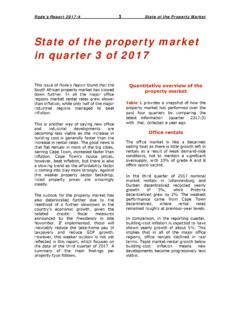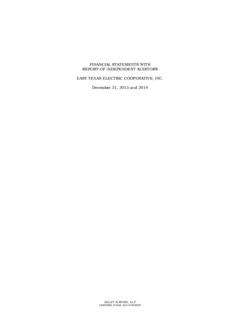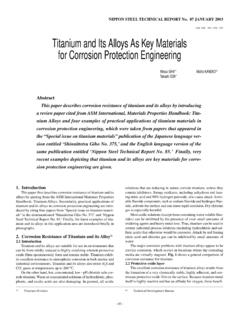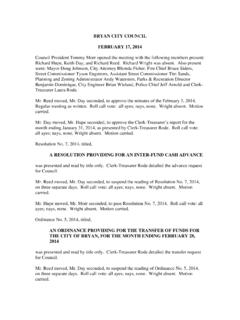Transcription of One City - Welcome to NYC.gov
1 One city Built to Last Technical Working Group report TRANSFORMING NEW york city BUILDINGS. FOR A LOW-CARBON FUTURE. The city of New york Mayor Bill de Blasio Mayor's Office of Sustainability One city Built to Last Technical Working Group report TRANSFORMING NEW york city BUILDINGS. FOR A LOW-CARBON FUTURE. The city of New york Mayor Bill de Blasio Mayor's Office of Sustainability 2nd Edition TABLE OF CONTENTS. EXECUTIVE SUMMARY 1. Background Major Findings and Next Steps Summary of Research and Analysis 1: BACKGROUND & BUILDING SECTOR ANALYSIS 17. Introduction Analysis of New york city Buildings Today and In 2050. 2: REDUCING ENERGY USE IN EXISTING BUILDINGS 33. Characteristics of Existing Buildings Efficiency Measures On-Site Distributed Generation Measures Comprehensive Building System Upgrades 3: DESIGNING FOR WHOLE BUILDING ENERGY PERFORMANCE 101. Impact of Future Buildings 4: GHG REDUCTIONS FROM ALL BUILDINGS 117.
2 Realizing the Full Potential of GHG Reductions in Buildings Tenant Energy Use and Other Unregulated Loads Building Workforce Capacity Bringing Down the Costs of Energy Efficiency Improvements 5: CONCLUSION 135. 6. APPENDIX 141. 7. END NOTES 147. Acronyms and Abbreviations Letter from the Mayor Friends, Climate change is an existential threat to humanity, and New york city is on the front lines. That's why we are committed to reduce our greenhouse gas emissions 80 percent by 2050. The comprehensive report of the Buildings Technical Working Group that we release today marks a milestone in our fight against climate change. In September 2014, when we announced our 80 x 50 target in One city : Built to Last, we committed to launch a task force and assess how to place our buildings on a pathway to achieve this vital goal. Following this commitment, the Buildings Technical Working Group engaged in a collaborative, data-driven effort that was unprecedented in its level of ambition and the depth of research on actual buildings and how they use energy.
3 More than 50 leaders in real estate, architecture, engineering, construction, finance, affordable housing, and environmental justice, in addition to countless city staff and volunteers, met for more than a year to deliver the recommendations in this report . With their assistance, the city also conducted the most comprehensive analysis of energy use in New york city 's buildings to date. The data showed us the best opportunities for buildings to reduce GHG emissions and put New york city on a pathway to 80x50. This report and its recommendations were created by New Yorkers, for New Yorkers. In this report you will be able to explore the way energy is used in New york city buildings, the most common types of buildings citywide, and the most effective strategies to reduce energy use and GHG emissions in both new and existing buildings. In addition to these findings, we have outlined a series of new actions that the city will take, including adopting new codes and measures for energy performance, requiring comprehensive upgrades to heating distribution systems, and integrating deep energy retrofits into capital planning.
4 The initiatives in this report will save building owners on energy costs, cut greenhouse gas emissions, and improve our air quality. They will create jobs, and improve the comfort and quality of the spaces where New Yorkers live, work, and play. They are an investment in our future. Together, these initiatives will help New york city rise to the global challenge of averting the most disastrous impacts of climate change and protect the planet for future generations to come. Mayor Bill de Blasio Acknowledgements This valuable work was conducted by more than 50 leaders from New york city 's world-class real estate, engineering, architecture, labor union, affordable housing, academic, government, and environmental advocacy sectors who were appointed to serve on the Buildings Technical Working Group (TWG). This unprecedented level of effort would not have been possible without the following individuals and organizations.
5 Director Nilda Mesa The incredibly hardworking staffs at HDR, Inc. and the Department New york city Mayor's Office of Sustainability of Buildings, Department of city Planning, Department of Citywide Commissioner Vicki Been Administrative Services, Department of Design and Construction, Department of Housing Preservation and Development Department of Housing Preservation and Development, Landmarks Preservation Commission, New york city Housing Authority, Office Commissioner Rick Chandler of Sustainability, Office of Management and Budget, and the School Department of Buildings Construction Authority; and a special thanks to: Commissioner Lisette Camilo Ellen Abramowitz, Mina Agarabi, Brian Baldor, Denis Belic, Chris Department of Citywide Administrative Services Benedict, Josh Berengut, Jonathan Beuttler, Jennifer Bienemann, President Lorraine Grillo Michael Blasnik, Jason Block, Gina Bocra, Tara Boirard, Eric Boorstyn, School Construction Authority Daniel Bower, Jeff Brodsky, Ryan Cassidy, Margaret Castillo, Christopher Cayten, Nicole Ceci, Kimberly Darga, Jennifer Davis, Chair Shola Olatoye Minelly De Coo, Emily Dean, Donna DeCostanzo, Michael DeLoach, New york city Housing Authority Jonathan Dickinson, David Dimitri, Dan Donnelly, Richard Eiden, Commissioner Feniosky Pe a-Mora Thomas Eisele, Luke Falk, Gary Fescine, Yetsuh Frank, Amy Furman, Department of Design and Construction Jocelyn Gan, Chris Garvin, John Gearrity, Diana Glanternik, Erick Commissioner Carl Weisbrod Gregory, Elizabeth Hanson.
6 Chris Haun, Cory Scott Herrala, Department of city Planning Melanie Ho, Emily Hoffman, Michael Ingui, Bomee Jung, Eric Kane, Larry Katz, Nidhi Khanna, Jennifer Klein, Ben Kornfield, Serguei Kouznetsov, Talia Kula, Emily Kurtz, Jonah Lee, John Lee, Stacy Lee, Luke Leung, Ken Levenson, Alexandra Levine, Aaron Lewis, Gwendolyn Litvak, Patrick Love, Ross MacWhinney, Samuel Man, Michael Marrella, Richard Morales, Robert Muldoon, Jennifer Nagle, Robin Neri, Heather Nolen, Ozgem Ornektekin, Thomas Paino, Cathy Pasion, Francis Redhead, Dan Rieber, Jeff Rios, Luis Rios, Lindsay Robbins, Paul Rode, Paul Romano, George Roussey, Kristine Ryan, Arianna Sacks-Rosenberg, Grant Salmon, Pinky Samat, Holly Savoia, Scott Short, Howard Slatkin, Laura Slutsky, Amy Spitalnick, Chris Starkey, Carter Strickland, Wilson Suarez, Amy Sugimori, Laura Tajima, Jenna Tatum, Shanta Tucker, Dara Yaskil, and Mark Zimet Roger Anderson Vicki Kuo Daniel Avery Consolidated Edison, Inc.
7 Building Owners and Managers Association Dominique Lempereur Ryan Baxter KW Engineering, Inc. Real Estate Board of New york Paimaan Lodhi Michael Bobker Real Estate Board of New york CIUS Building Performance Lab, city College of New york , CUNY Murray Levi, AIA LEED AP. Gene Boniberger IFMA International Facility Managers Association Rudin Management Co., Inc. Terri Ludwig Louis Coletti Enterprise Community Partners Building Trades Employers' Association of New york city Tony Malkin Michael Colgrove Empire State Realty Trust New york State Energy Research and Development Authority Charlie Marino (AKF Group). Rebecca Craft American Society of Heating, Refrigerating, & Air-Conditioning Engineers Consolidated Edison, Inc. Bobbi McGowan David Davenport Building Owners and Managers Association Urban Greenfit Jolie Milstein Aurelio Mark de Yoanna New york State Association for Affordable Housing National Grid Juan Camilo Osorio Christopher Diamond The New york city Environmental Justice Alliance New york city Energy Efficiency Corporation Steve Pekofsky Natasha Dwyer Glenwood Management Corp.
8 The New york city Environmental Justice Alliance Frank Ricci Wilmouth Elmes PE Rent Stabilization Association Manhattanville Development Group/Columbia University Mary Ann Rothman H ctor Figueroa Council of New york Cooperative and Condominiums 32BJ Service Employees International Union Dana Robbins Schneider Wendy Fok JLL, Empire State Realty Trust Natural Resource Defense Council-Center for Market Innovation Cecil Scheib Scott Frank Urban Green Council American Council of Engineering Companies of New york Laurie Schoemann Jonathan Flaherty Enterprise Community Partners Tishman Speyer Patrick Siconolfi Nancy Aber Goshow Community Housing Improvement Program American Institute of Architects New york Zach Stern Alexandra Hanson Local 94 Operating Engineers New york State Association for Affordable Housing Russell Unger Nicholas Holt Urban Green Council Skidmore, Owings & Merrill, LLP Elizabeth Velez Carl Hum Velez Organization Real Estate Board of New york Michael Northrop Brook Jackson Rockefeller Brothers Fund Partnership for New york city Lee Wasserman Aaron Jones Rockefeller Family Fund 32BJ Service Employees International Union Donald J.
9 Winston PE FASHRAE. Ilana Judah (FXFOWLE) Jennifer Wilcox New york Building Congress city Council Speaker's Office Josh Kellermann Steven Winter ALIGN: The Alliance for a Greater New york Steven Winter Associates, Inc Judi Kende Richard Yancey Enterprise Community Partners Building Energy Exchange Laurie Kerr Marc Zuluaga Urban Green Council Steven Winter Associates, Inc. Nico Kienzl Atelier Ten 80. X. 50. EXECUTIVE SUMMARY. Climate change is an existential threat to New york city and humanity. As the climate changes, New york city faces the prospect of more frequent and intense extreme weather events including storms, heavy downpours, heat waves, droughts, and high winds. Chronic conditions such as rising sea levels, higher average temperatures, and increased annual precipitation will exacerbate these extreme weather events and their impacts on the city 's residents. Cities play an important role in addressing global climate change and mitigating these risks.
10 More than half of the world's inhabitants live in urban areas, where population growth is expected to continue through the 21st century. Already, cities are responsible for more than 70 percent of global energy-related carbon dioxide In September 2014, New york city Mayor Bill de Blasio committed to reduce New york city 's greenhouse gas (GHG) emissions 80 percent below 2005 levels by 2050 (80 x 50), joining other leading cities around the world in committing to the target the United Nations set for developed countries to avert the worst impacts of climate change. Since then, the Mayor has committed to additional targets, which include the Under 2 MOU, a commitment among subnational governments to limit GHG emissions to under two metric tons of carbon dioxide equivalent (tCO2e) per capita, and an interim target of a 40 percent GHG reduction by 2030 (40 x 30). Because the energy used in New york city 's buildings accounts for nearly three-quarters of citywide GHG.


















